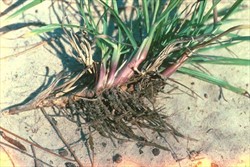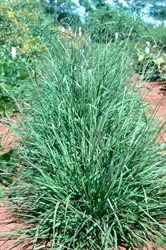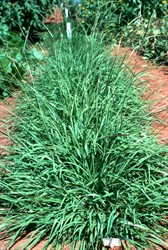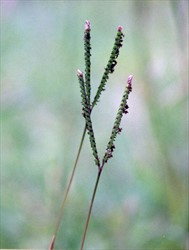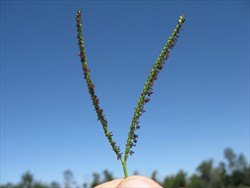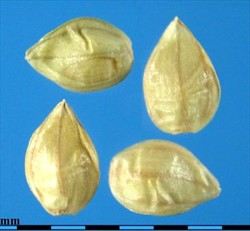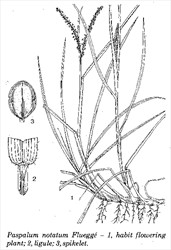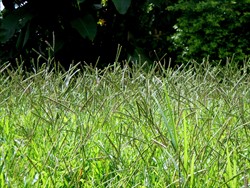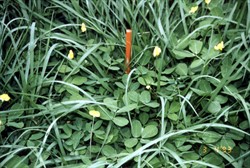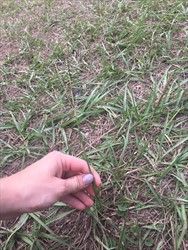Paspalum notatum
Tropical Forages
Paspalum notatum Flüggé
Subordinate taxa:
Paspalum notatum Flüggé var. notatum
Paspalum notatum Flüggé var. saurae Parodi
var. notatum: Paspalum notatum Flüggé var. latiflorum Döll
Family: Poaceae (alt. Gramineae) subfamily: Panicoideae tribe: Paspaleae subtribe: Paspalinae group: Notata.
Polymorphic, sward-forming perennial, with fibrous, stolon-like, elongated rhizomes to >5 mm diameter, with short internodes; bearing shoots and deep fibrous roots at the nodes. Leaves crowded at the bases of the culms, the overlapping sheaths tending to reach a common height, with blades stiffly spreading above; leaf blades glabrous to hairy (leaf pubescence can vary with vigour of the plant, glabrous in vigorous growth, pubescent in depressed growth); linear-lanceolate to linear, 3‒12 mm wide, 2‒5 cm long near the rhizome tip, 15‒30 cm long in the upright shoots arising from the nodes, apex acuminate; ligule a membranous rim with a row of dense white hairs about 1 mm behind it. Culms erect, 20‒50 (‒90) cm tall. Inflorescence a panicle, usually comprising two terminal racemes (rarely sub-conjugate to 5), (3‒) 5‒10 (‒15) cm long, with spikelets inserted in two rows along the underside of the 1 mm wide rachis. Spikelets glabrous, brownish-tinged, plumply plano-convex, ovate to obovate, 2.5‒4 mm long, 2‒3 mm wide. 250,000‒550,000 seeds per kg.
var. notatum: 2n = 4x = 40; broad leaves; racemes recurved, ascending; spikelets 3‒3.5 mm long × 2.5 mm wide; 250,000‒310,000 seeds per kg.
var. saurae: 2n = 2x = 20; narrow leaves; racemes sub-erect; spikelets 2.8‒3 mm long × 2 mm wide; 500,000‒550,000 seeds per kg.
Africa: notatumgras (Afrikaans)
Asia: بسبالوم نوثاثوم (Arabic); 百喜草 bai xi cao (Chinese); rumput pencasilan (Indonesia); バヒアグラス bahia garusu, amerika suzume no hie, kyuushu suzume no hie; oni suzume no hie (var. saurae) (Japanese); ya-bahia (Thai); san dấu (Vietnamese)
English: bahia grass, bahiagrass; paraguay paspalum, beira grass (Zimbabwe)
Europe: herbe de bahia (French); Bahiagras (German); erba di bahia (Italian)
Latin America: capim bahia, capim batatais, capim de cabayu, grama-batatais, grama comprida, grama-da-bahia, grama-forquilha, grama forquinha, grama mato grosso (Portuguese); jenji brillo, gengibrillo (Costa Rica); tejona (Cuba); zacate bahia (Mexico); alpargata, cambute, cañamazo, capií horqueta, champa, gengibrillo, gramilla blanca, grama común, grama dulce, grama nativa, grama negra, grama trenza, gramilla blanca, gramillón, hierba de bahía, pasto bahía, pasto horqueta, pasto manso, pasto remolino, sacasebo (Spanish); ka’alañí letaá (Mocoví)
var. notatum
Native:
Northern America: Mexico (Chiapas, Colima, Federal District, Guerrero, Hidalgo, Jalisco, Michoacán, Morelos, Nayarit, Nuevo León, Oaxaca, San Luis Potosí, Tamaulipas, Veracruz)
Caribbean: Antigua and Barbuda; Cuba; Dominica; Grenada; Guadeloupe; Jamaica; Martinique; Montserrat; Puerto Rico; St. Lucia; St. Vincent and The Grenadines
Central America: Belize; Costa Rica; El Salvador; Guatemala; Honduras; Nicaragua; Panama
South America: Argentina (Córdoba, Mendoza, Buenos Aires, Chaco, Corrientes, Entre Ríos, Formosa, Jujuy, Misiones, Salta, Santa Fe, Santiago del Estero, Tucumán); Bolivia (Cochabamba, Beni, Chuquisaca, La Paz, Santa Cruz, Tarija); Brazil (Bahia, Federal District, Goiás, Mato Grosso, Minas Gerais, Paraná, Rio de Janeiro, Rio Grande do Sul, Santa Catarina, São Paulo); Paraguay; Peru; Uruguay
Cultivated/naturalized:
Africa: Kenya; South Africa
Australasia: Australia (New South Wales, Northern Territory, Queensland)
Northern America: USA (s.e.)
Probably elsewhere in tropics and subtropics
var. saurae
Native:
South America: Argentina (Corrientes, Entre Ríos, Misiones, Santa Fe); Bolivia (Chuquisaca); Brazil (Mato Grosso do Sul, Paraná, Santa Catarina); Paraguay (Caazapa, Central, Itapua, Misiones); Uruguay
Cultivated/naturalized:
Australasia: Australia (New South Wales, Queensland)
Northern America: USA (Florida, Louisiana, Texas)
Forage
Used as permanent forage for intensively grazed pastures. Recommended more for beef than for milk production. If well fertilized and vigorous it can make useful hay.
Environment
Used as a stable drought-resistant, ground cover/soil binder, particularly in traffic and shaded areas. Suitable for agroforestry.
Other
It is used as a ley in four-year rotations to reduce nematode damage to tomatoes (Lycopersicon esculentum) and peanuts (Arachis hypogaea).
Soil requirements
P. notatum is commonly found on sandy or light textured soils over its native and naturalized range, and sometimes extends onto clays. While preferring fertile soils, it can maintain dense stands on infertile soils, probably due to nitrogen fixation in the rhizosphere (see "Fertilizer" and "Other comments"). It grows on soils with pH of (4.3‒) 5.5‒6.5 (‒8.4), and presumably has moderate tolerance of aluminium. Iron chlorosis can develop on less acid soils in spring and autumn. Some types, at least, are salt tolerant, withstanding up to 4,500 ppm NaCl in irrigation water. Photosynthesis and transpiration are reduced when NaCl levels reach 9,000‒27,000 ppm. Responds well to nitrogen fertilizer.
Roots of P. notatum develop an association with arbuscular mycorrhizal fungi (AMF) and the free living, diazotrophic (nitrogen-fixing) bacterium, Azotobacter paspali. AMF isolated from root and soil samples are primarily from the genera, Glomus and Endogene. N fixation by Azotobacter paspali is estimated to be of the order of 10‒20 kg/ha/yr N, and may be as high as 90 kg/ha/yr.
Moisture
Rainfall in its native habitat mostly ranges from 700 to 1,500 mm year. It is generally sown in areas with a well-distributed annual rainfall of c. 900‒1,500 mm, but can be used at up to 2,500 mm. It is very drought tolerant by virtue of its deep root system, and is fairly tolerant of flooding, surviving over 30 days of inundation. In shallow soils, it is not unusual to see colonies of P. notatum with dead centre and actively growing surround, due possibly to exhausted moisture and/or nutrient.
Temperature
P. notatum occurs naturally between 25° N and 32° S, and is now naturalized to 35°N in the USA, and about 30° S in Australia. It also occurs from sea level to over 2,300 m asl (Bolivia and Mexico), representing an average annual temperature range of about 17‒25 ºC. Frosts occur over a significant part of its range. Optimum temperature for germination is 30‒35 °C, for growth, 25‒30 °C, and for tillering, 20‒25 °C. Little growth occurs in the cooler months. Tops are burnt off by frost, and are killed when temperatures fall below -10 to -12 °C. Most tetraploids do not survive winter in southwest Japan. Night temperatures below 13 °C inhibit flowering. Var. saurae tends to be more cold tolerant than most var. notatum types.
Light
Bahia grass is moderately tolerant of reduced light, but is not as shade tolerant as Paspalum malacophyllum or P. wettsteinii. It may persist better under sustained grazing in shaded situations than these other species.
Reproductive development
It is a long-day plant, with flowering commencing early to mid-summer, depending on genotype, e.g. 'Pensacola' flowers earlier than 'Argentine'.
Defoliation
P. notatum is a low-growing grass that can tolerate constant or frequent defoliation, and requires intensive management to maintain quality.
Fire
It can tolerate light to moderate fire, but stands can be diminished by fire if there is an abundance of dry fuel.
Guidelines for establishment and management of sown forages.
Establishment
P. notatum can be planted vegetatively or from seed. Vegetatively, it is readily established from rhizome pieces or from turfs/sods. Manually harvested seed mostly has a high level of dormancy that breaks down over a period of up to 3 years. Hammer-milling dormant seed or treatment with sulphuric acid helps to break dormancy. However, machine-harvested seed from the previous season is usually suitable for sowing. Seedlings develop slowly, so to minimise competition, a clean, weed-free seedbed is required. Seed should be placed up to 1 cm deep (or on the surface), and rolled with a heavy roller. Seed is normally sown at 2‒5 kg/ha. Stands developed from low sowing rates may take 1‒3 years to achieve a good cover, much slower than with P. lepton. Rate of cover can be improved by using higher sowing rates (up to 20 kg/ha), irrigation if required, applications of fertilizer, and weed control. Broad-leafed weed growth during establishment is best controlled with mowing every three to four weeks, since P. notatum seedlings are susceptible to phenoxy herbicides.
Fertilizer
P. notatum is capable of surviving, but not thriving, in infertile soils, partly as a result of root associations with arbuscular mycorrhizal fungi (AMF) and the diazotrophic (nitrogen fixing) bacterium, Azotobacter paspali. The grass responds to applications of nitrogen up to 200 or more kg/ha per year. Applications of phosphorus can lead to improved tillering and forage and seed yields. 'Pensacola' has been killed by excessive application of lime-stabilised sludge, where soil pH in the top 30 cm was raised to 7.3. Iron application may be necessary on less acid soils if iron chlorosis develops. Older stands can become open and moribund if not adequately fertilized and renovated.
Compatibility (with other species)
Once established, bahia grass is a very competitive species, particularly in situations where it is regularly defoliated. It tends to develop into near monospecific swards, with few legumes or other grasses. As fertility declines, it can invade pastures of normally competitive but more fertility-demanding species such as Cynodon dactylon and Urochloa decumbens. This competitiveness can be used to advantage in suppressing weedy grasses such as Sporobolus pyramidalis and Eragrostis curvula.
Companion species
Grasses: Paspalum lepton, Axonopus fissifolius.
Legumes: Aeschynomene americana, Arachis glabrata Arachis pintoi, Trifolium repens, Trifolium semipilosum and Vigna parkeri; Aeschynomene falcata, Listia bainesii and Stylosanthes guianensis var. intermedia on infertile soils only.
Pests and diseases
While many pests and disease organisms have been recorded in association with this species, few, if any, have any significant impact on its long-term performance. There is also genetic resistance to many of the diseases. The main fungal disease is ergot caused by Claviceps paspali, which is not a problem in 'Pensacola', but can seriously reduce seed yields of 'Argentine'. Leaf lesions caused by Helminthosporium micropus (Bipolaris micropus) have been noted on 'Argentine' and 'Riba'. Other pathogenic fungi found on P. notatum include Cladosporium herbarum, Claviceps purpurea, Colletotrichum graminicola, Fusarium heterosporum, Omphalia sp., Phyllachora andropogonis (P. cornispora), Puccinia substriata, Sclerotinia (dollar spot), Sphacelotheca paspali-notati, and Ustilago paspali.
Many P. notatum, including 'Paraguay', are resistant to root knot nematode (Meloidogyne spp.), and are used in rotations with crops susceptible to nematodes to reduce populations. 'Paraguay 22' is resistant to the sting nematode (Belonolaimus longicaudatus) that affects 'Pensacola'. Other nematodes isolated from bahiagrass include Helicotylenchus cavenessi, H. dihystera, H. pseudorobustus, Hoplolaimus pararobustus, Pratylenchus brachyurus, P. pratensis, Radopholus similis, Scutellonema clathricaudatum, Trichodorus christiei, Tylenchorhynchus claytoni, Xiphinema ifacolum.
The main insect pests are tawny mole cricket (Scapteriscus vicinus Gryllotalpidae), southern mole cricket (S. borellii), and short-winged mole cricket (S. abbreviatus), which feed on the roots, leading to thinning of stand and patch death. Biological control measures are proving successful with this pest in Florida, USA. Army worms (Spodoptera spp.) can temporarily damage stands, particularly if they are well fertilized. Ripening seed crops are attractive to seed-eating birds, and mature seed is to mice and rats.
Ability to spread
P. notatum spreads slowly but surely. Poor seedling competitiveness limits spread, but once plants are established, they spread strongly by virtue of the stout ground-appressed rhizomes, and strong root system. Viable seed is spread readily in animal dung.
Weed potential
Although a useful turf in its own right, it can become a weed of finer turf and urban parks, and is also sometimes perceived as a weed of pasture. It is not an important weed of annual crops because of the slow seedling development. It is readily ploughed out.
Nutritive value
Feeding value varies greatly with age of regrowth, genotype and fertility of soil. Crude protein levels can be >20% in 2-week regrowth, declining to about 5% by 12 weeks, with IVOMD declining from almost 70% to 50% in the same period. P levels average about 0.3%, Ca 0.5%, and Mg about 0.2%.
Palatability/acceptability
Palatability varies with age, genotype and soil fertility. Although young growth is readily eaten, the species generally, and 'Pensacola' in particular, are increasingly poorly eaten with age. It is essential to maintain grazing pressure to avoid this decline in palatability. Nitrogen fertilization of 'Pensacola' has a beneficial effect on intake. However, farmers in Queensland, Australia, have noted a strong animal preference for broad-leafed var. latiflorum types over 'Pensacola' at all stages.
Toxicity
No major toxicity has been reported. Levels of HCN in the DM of 28 ppm have been measured, but this is unlikely to cause problems, which usually occur when levels in the green matter exceed 200 ppm. There is the potential for ergotism caused by Claviceps in the seedhead, but no problem has been documented.
Feedipedia link
Dry matter
Annual dry matter yields of heavily fertilized and irrigated P. notatum may exceed 20 t/ha, but under rain-grown moderately fertilized conditions, are mostly between 3 and 8 t/ha.
Animal production
Pastures fertilized with 100‒200 kg/ha N can produce 400‒600 kg/ha/yr liveweight gain and can carry 5 head/ha during the growing season.
Var. notatum 2n = 40 (apomict)
Var. saurae 2n = 20 (sexual).
Var. saurae outbreeds due to self-incompatibility. Sexual tetraploids, required to improve the apomictic types, have been created by doubling the chromosomes in the sexual diploid, 'Pensacola'. These sexual tetraploids were used as females when crossed with apomictic males. This produced highly variable progenies that contained both sexual and apomictic plants. The F2 from sexual × apomictic crosses shows that apomixis in tetraploids is mostly recessive.
Crops need to be managed carefully in relation to defoliation management and fertilization prior to commencement. In the subtropics of the northern hemisphere, flowering commences in June for 'Pensacola' and 'Tifton 9', and July for 'Argentine', with 'Paraguay' intermediate. It is important to remove excessive growth to avoid shading of the base of the shoot, which leads to reduced seed production. This is best affected by burning excessive growth in January or February, and maintaining a heavy stocking until seed heads begin to elongate in June/July. The normal procedure is to graze the paddock heavily (to c. 7 cm) during spring following a dressing of 50‒75 kg/ha N in February/early March (preferably as a mixed fertilizer), and follow up with a further 50‒75 kg/ha N in the boot stage in late April/June. Seed ripens progressively over the summer and at no time is all the seed mature. It can be combine harvested in a single pass, or harvested over a number of passes with a beater or stripper to maximise yields yields. Commercial seed yields average 60‒100 kg/ha, but can be up to 600 kg/ha ('Riba') when good production and harvesting practices are used.
Var. saurae can be controlled using metsulfuron methyl at 10 g /ha a.i., in association with a non-ionic surfactant in 200 L water. Var. notatum cultivars tested showed four- to five-fold increased tolerance to metsulfuron compared with 'Pensacola'. Small seedlings of P. notatum are sensitive to phenoxy herbicides and thus mowing must be used to control weeds until the plants are 10‒12 cm tall and well established at which time a phenoxy herbicide can be used to control broadleaf weeds. Hexazinone and triclopyr can be used for weed control in mature stands.
- Adapted to wide range of soil types.
- Tolerates acid/low fertility soils.
- Fair shade tolerance.
- Good drought tolerance.
- Few pest or disease problems.
- Tolerant of close grazing and traffic wear.
- Suppresses weeds once established.
- Responds well to nitrogen.
- Some nitrogen fixation.
- Slow rate of establishment.
- Seedlings susceptible to phenoxy herbicides.
- Relatively unpalatable once mature.
- Can become moribund with time.
- Not suitable for high pH soils (can develop iron chlorosis).
- Difficult to mow due to characteristics of the peduncle.
Acuña, C.A., Martínez, E.J., Zilli, A.L., Brugnoli, E.A., Espinoza, F., Marcón, .F, Urbani, M.H. and Quarin, C.L. (2019) Reproductive systems in Paspalum: Relevance for germplasm collection and conservation, breeding techniques, and adoption of released cultivars. Frontiers in Plant Science. 10: 1377. https://doi.org/10.3389/fpls.2019.01377
Adjei, M.B., Mislevy, P. and Chason, W. (1992) Seed yield of bahiagrass in response to sward management by phenology. Agronomy Journal 84:599–603. doi.org/10.2134/agronj1992.00021962008400040011x
Adjei, M.B., Mislevy, P. and Chason, W. (2000) Timing, defoliation management, and nitrogen effects on seed yield of ‘Argentine’ bahiagrass. Agronomy Journal 92:36–41. doi.org/10.2134/agronj2000.92136x
Baki, B.B., Ipon, I.B. and Chen, C.P. (1992) Paspalum notatum Flueggé. In: Mannetje, L.’t and Jones, R.M. (eds) Plant Resources of South-East Asia No. 4. Forages. Pudoc Scientific Publishers, Wageningen, the Netherlands. p. 181–183. edepot.wur.nl/327785
Beaty E.R., Stanley R.L. and Powell, J. (1968) Effect of height of cut on yield of Pensacola bahiagrass. Agronomy Journal 60:356–358. doi.org/10.2134/agronj1968.00021962006000040007x
Bogdan, A.V. (1977) Tropical Pasture and Fodder Plants. Longman Inc., New York, USA. p. 205–212.
Filgueiras, T.S. and Rodrigues, R.S. (2016) Paspalum notatum (Grama-batatais). In: Vieira, R.F., Camillo, J. and Coradin, L. (eds) Espécies Nativas da Flora Brasileira de Valor Econômico Atual ou Potencial: Plantas para o Futuro ‒ Região Centro-Oeste. Secretaria de Biodiversidade, Ministério do Meio Ambiente, Brasília, DF, Brazil. p. 669‒673. https://bit.ly/2UMZUzo
Gates, R.N., Hill, G.M. and Burton, G.W. (1999) Response of selected and unselected bahiagrass populations to defoliation. Agronomy Journal 91:787–795. doi.org/10.2134/agronj1999.915787x
Hacker, J.B., Williams, R.J., Vieritz, A.M., Cook, B.G. and Pengelly, B.C. (1999) An evaluation of a collection of Paspalum species as pasture plants for southeast Queensland. Genetic Resources Communication No. 32. CSIRO Tropical Agriculture, St Lucia, Australia. bit.ly/3dLHRkq
Kretschmer Jr., A.E. and Hood, N.C. (1999) Paspalum notatum in Florida, USA. In: Loch, D.S. and Ferguson, J.E. (eds) Forage seed production, Volume 2: Tropical and subtropical species. CABI Publishing, Wallingford, Oxon, UK. p. 335–340.
'Argentine' (PI 148996) Released in Florida, USA (1950). Var. notatum. A tetraploid, introduced from Argentina in 1944. A medium broad-leaf type (leaves broader than 'Pensacola'), which is more frost resistant than 'Common' and 'Paraguay'. Requires good moisture levels for germination and establishment, normally germinating in 10‒20 (av. 14) days. Poor early spring growth but grows well in later summer and autumn. Less cold tolerant and less productive in winter than 'Pensacola'. 'Argentine' seedheads are significantly damaged by ergot (Claviceps paspali). Superior to 'Pensacola' as a turf because of its more prostrate, denser appearing growth habit and because it puts up fewer seedheads. Considered to be more palatable than 'Pensacola'.
'Aruaí' Released in Brazil (2017) as an 'environmental grass' for use as permanent soil surface coverage in situations such as road, railway and airfield margins.
'AU-Sand Mountain' Auburn University has recently approved the release of "AU Sand Mountain" bahiagrass (P. notatum var. saurae). AU Sand Mountain is the result of a natural selection in a plant introduction thought to have been planted at the Sand Mountain Substation (Crossville, Alabama) some 30 years ago. The variety has narrow leaves, fine tillers and a short inflorescence. In Alabama, bahiagrass is generally grown in the southern part of the state, generally south of Interstate Highway 85. There, AU-Sand Mountain has out-yielded ‘Pensacola’ and ‘Argentine’ varieties, but yielded less than ‘Tifton 9’. In the northern part of Alabama, this new variety has yielded more than Tifton 9, and even out-yielded bermudagrass. Plans for the new release will include testing and marketing in the more northerly regions of the Southeast. The PVP application is in progress.
‘Boyero UNNE’ (Reg. No. CV-5, PI 676021) Released by the National University of the Northeast (UNNE), Argentina (2012). A tetraploid, highly apomictic F1 hybrid between an experimentally obtained female parent, reproducing sexually, and an apomictic, wild bahiagrass genotype. More upright growth habit than other tetraploid bahiagrass cultivars currently in use or wild tetraploid biotypes. It can produce approximately 19% more forage dry matter than its apomictic male parent, 20–51% more than the wild bahiagrass type currently found in natural pasturelands of northeastern Argentina, and 4–26% more than 'Argentine' at three locations in Florida, USA.
'Common' Released in Florida, USA (1913). Low growing, with short, broad, somewhat hairy leaves, and stems that grow 20–45 cm tall. The most common bahiagrass variety grown until the 1930s. Lower yielding than other cultivars. Slow to establish, low in productivity and sensitive to cold, it is no longer recommended.
'Competidor' (Kf.88, later P.1308) Released in NSW, Australia (1986). Introduced to Grafton Research Station from the USA in 1953 as 'Argentine' bahia grass. It is uncertain whether it is the same as the US cultivar. Selected from naturalized stands on the basis of vigour, palatability and freedom from disease. Considered a better pasture grass than the other naturalized species, Axonopus fissifolius, on soils of moderate to low fertility. Produces fewer seed heads and is more palatable and more shade tolerant than 'Pensacola'. Initially considered resistant to ergot, but recent observations reveal susceptibility in wet years. Competes strongly with weeds, but spreads laterally at a much slower rate than Cenchrus clandestinus and Cynodon dactylon. At 29.5º S, flowering commences in January-February and seed matures from mid-February to early April. Commercial seed yields rarely exceed 150 kg/ha.
'Maritaca' Released in Brazil (2017) as an 'environmental grass' for use as permanent soil surface coverage in situations such as road, railway and airfield margins. Potential also for use as amenity, being narrow-leaved, low-growing, rhizomatous plants, tolerant of mowing.
'Nangoku' Released in Kagoshima, Japan (1983). Synthetic sexual diploid originating from 5 selected clones of Pensacola 64-P. Semi-erect growth habit. Selected for palatability, high yield, winter survival and early spring vigour. Used for grazing and hay at altitudes below 400 m in southern Kyushu, Japan.
'Nan-ou' (PI 556953) Released in Kagoshima, Japan (1991). Apomictic tetraploid cultivar (2n = 40). Mass selection from PI 284172 ( = CPI 21339) 'Argentine' from Costa Rica. Wider leaves, lower plant height and number of heads at harvest, and more palatable than diploids such as 'Nangoku'. Produces more forage than 'Nangoku' in summer and autumn. Used for grazing and hay. Adapted to lower altitudes in southern Kyushu, Japan.
'Nanpu' (PI 420018) Released in Japan (1969). Diploid originating from 2 generations of maternal selection of 4 diploid introductions. Similar yielding ability and palatability to 'Shinmoe', but less productive than 'Nangoku'. Good winter survival. Used for grazing. Replaced by 'Shinmoe', and commercial seed no longer available.
'Paraguay' (APG 63226) Released in USA (1938). Introduced from Paraguay. Forms a dense sod. Leaf blades hairier and narrower than 'Common'. Less cold tolerant and less winter-productive than 'Pensacola'. Seeds heavily. Provides satisfactory pasture until it becomes less palatable during summer. No longer used.
'Paraguay 22' Released in USA (1947). Var. notatum. Introduced from Paraguay. Similar to 'Argentine' in growth and flowering habit, and in cold tolerance, but greater ergot resistance. More productive than 'Paraguay'.
'Pensacola' (PI 422024) Released in Florida, USA (1944). Var. saurae. Chance introduction to Pensacola, Florida. Narrow-leaved like 'Paraguay', but longer and less hairy. Seeds are smaller than those of 'Common' or 'Paraguay', and more seeds are produced per head. It seeds heavily, but the seed shatters badly. Higher vigour and more productive than 'Common'. Although top growth is usually killed by moderate frost, it is more cold tolerant than other cultivars, producing more early and late season forage. Drought tolerant with roots to 2–3 m deep. Fairly resistant to ergot.
'Riba' (CPI 23944) Released in NSW, Australia (1995). Introduced from Uruguay as an ergot resistant P. dilatatum. Has shorter, stiffer leaves and shorter racemes than 'Pensacola' and 'Competidor' resembling a dwarf 'Pensacola'. Selected for low stature, dark green leaf colour and ergot resistance, as a turf variety, but can be used as forage. Adapted over a wide range of soil types, and maintaining a better turf appearance under low fertility and reduced mowing than other varieties. Very slow early growth. Seed does not shatter, and yields up to 600 kg/ha have been achieved.
'Shinmoe' (PI 420019) Released in Japan (1973). Diploid. High yielding synthetic of 5 clones selected from 70 elite diploid clones. Better germination, early vigour and spring growth than 'Nanpu'. Adapted to southern Kyushu, Japan. Has been replaced by 'Nangoku', and commercial seed is no longer available.
'Tifhi-1' (NSL 4715) Released in USA (1957). Hybrid developed from 'Pensacola' using two self-sterile cross-fertile clones and selecting among the F1 generation. Leafier, more shatter-resistant seed, and higher yielding than 'Pensacola'. Reported to give higher beef gain per hectare than 'Pensacola'. Due to difficulty and expense of seed production it is not available for commercial use.
'Tifhi-2' (NSL 20064) Released in USA (1961). Hybrid developed from 'Pensacola' using two self-sterile cross-fertile clones and selecting among the F1 generation. Leafier, more shatter-resistant seed, and higher yielding than 'Pensacola'. Reported to give higher beef gain per hectare than 'Pensacola'. Due to difficulty and expense of seed production it is not available for commercial use.
'TifQuik' (Reg. No. CV-4, PI 648303, PVP No 200700209) Released by the USDA and the University of Georgia (2008). Has flower level of hard seededness, resulting in more rapid stand establishment. Grows faster than 'Tifton 9' or 'Pensacola' in spring, because of increased seedling emergence.
'Tifton 9' (PI 531086) Released in Georgia, USA (1987). Hybrid produced from 'Pensacola' in 9 cycles of recurrent restricted phenotypic selection. Morphologically similar to 'Pensacola', but more vigorous in seedling stage, with longer leaves, higher protein levels and palatability, greater frost tolerance, higher seed yields and 47% more forage than 'Pensacola', but of similar digestibility. Drought tolerant, and extending the range of P. notatum further north in the USA than 'Pensacola'.
'Tifton 54' Released in Georgia, USA. Hybrid apomict, superior to apomictic introductions in yield and winter-hardiness.
'Tuim' Released in Brazil (2017) as an 'environmental grass' for use as permanent soil surface coverage in situations such as road, railway and airfield margins. Potential also for use as amenity, being narrow-leaved, low-growing, rhizomatous plants, tolerant of mowing.
'UF-Riata' Released by University of Florida (2007). Selected from 'Pensacola' for further improvement in early spring and late fall production, extending grazing into late fall and early spring in areas where bahiagrass is adapted.
'Wilmington' (PI 434189) Released in North Carolina, USA (1943, 1971). Var. notatum. Selected from a naturalized stand for cold tolerance. The most cold hardy of the US cultivars, with narrow leaves of medium size. Less productive than 'Pensacola' and 'Paraguay', and a poor seed producer. No longer used.
None reported.
